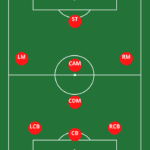- Last Updated -
Soccer Throw In – Soccer Law #15
What is a soccer throw-in? Imagine yourself watching a thrilling soccer match. The ball whizzes across the field, players skillfully dribbling and passing, until suddenly it goes out of bounds.
What happens next? This is where the soccer throw in comes into play.
A throw in is a method used to restart play after the ball has crossed the entire width of the touchline, either on the ground or in the air. It gives possession back to one of the teams, making it a crucial aspect of the game.

Definition and Purpose of Throw-Ins
A throw-in is a method used to resume play in soccer when the ball goes out of bounds along either sideline. It involves an outfield player using both hands from behind their head to throw the ball back onto the field while keeping both feet planted on or behind the touchline.
The primary purpose of throw-ins is to ensure fair play and maintain continuity by restarting matches quickly and efficiently.
Throw-ins come with certain rules that dictate how they are executed, ensuring fairness for both teams involved. By requiring players to use both hands and forbidding them from lifting their feet off the ground or crossing over into playing territory, these rules prevent unfair advantages such as gaining extra distance or an improper release angle.
Historical Background of Throw-Ins in Soccer
The origins of throw-ins can be traced back centuries ago when various forms of football were played across different cultures worldwide. However, it was during medieval times that a standardized set of rules started emerging for what would eventually become modern soccer.
In 1863, when The Football Association (FA) was established in England as football’s governing body, they codified numerous regulations including those related to throw-ins. These rules were pivotal in shaping how this particular restart was conducted, and they have endured minor modifications to this day.
Over the years, throw-ins have become an integral part of the game, offering players an opportunity to showcase their technique and strategic prowess.
From swift short throws to long-range missiles launched deep into enemy territory, throw-ins have evolved into a tactical weapon that teams can deploy strategically to create scoring opportunities or gain territorial advantage.

What Are The Soccer “Laws Of The Game”?
The “Soccer Laws of the Game” are a set of rules established by the International Football Association Board (IFAB) to regulate the play of the sport globally. These laws cover all aspects of the game, including the field of play, the ball, the number of players, players’ equipment, the referee, the duration of the match, the start and restart of play, and the methods of scoring.
The laws also detail the rules for free kicks, penalty kicks, throw-ins, goal kicks, and corner kicks. They specify the procedures for determining offside, misconduct, and the various types of fouls and infractions that can occur during a match.
The laws are updated periodically to adapt to the evolving nature of the sport and to promote fair play and player safety.
It’s important to note that while the IFAB establishes the basic laws, individual leagues and competitions may implement additional rules or modifications as long as they don’t contradict the fundamental principles of the IFAB’s laws.
Law Number 15 – Throw Ins
A throw-in ( also known as a “Set Piece”) in soccer is granted to the team opposing the player who last made contact with the ball, causing it to cross the touchline completely, whether on the ground or in the air. It’s important to note that a goal cannot be directly scored from a throw-in.
If the ball enters the opponents’ goal, a goal kick is awarded, while if it enters the thrower’s goal, a corner kick is awarded.
The procedure for a throw-in is as follows:
- The player executing the throw-in, or the thrower, must face the field of play.
- The thrower must have part of each foot either on the touchline or on the ground outside the touchline.
- The thrower must use both hands to deliver the ball from behind and over the head, from the point where the ball left the field of play.
- All opponents must maintain a minimum distance of 2 meters (or 2 yards) from the point on the touchline where the throw-in is to be taken.
The ball is considered in play once it enters the field of play. If it touches the ground before entering, the throw-in is retaken by the same team from the same position. If the throw-in is not executed correctly, it is retaken by the opposing team.
A player can deliberately throw the ball at an opponent to play the ball again, provided it’s not done in a careless, reckless manner, or with excessive force. In such a case, the referee allows play to continue. However, the thrower is not allowed to touch the ball again until it has made contact with another player.
Offences and sanctions during a throw-in include:
- If the thrower touches the ball again before it has made contact with another player, an indirect free kick is awarded. If the thrower commits a handball offence, a direct free kick is awarded. If the offence occurred inside the thrower’s penalty area, a penalty kick is awarded unless the ball was handled by the defending team’s goalkeeper, in which case an indirect free kick is awarded.
- An opponent who unfairly distracts or impedes the thrower, including moving closer than 2 meters (or 2 yards) to the place where the throw-in is to be taken, is cautioned for unsporting behavior. If the throw-in has been taken, an indirect free kick is awarded.
- For any other offence, the throw-in is taken by a player of the opposing team.

The Player Taking the Throw In
Positioning and Stance
When it comes to executing a throw-in, the player taking the throw-in must position themselves correctly. This means they need to be behind and perpendicular to the touchline, keeping both feet on or behind it until the ball is released.
It’s essential to stand in a way that provides maximum visibility of the field and allows for an accurate throw.
Typically, players will position themselves a few steps away from where the ball left the field of play. As for their stance, there are various approaches.
Some prefer a wider stance for better balance and power, while others opt for a more narrow stance for increased agility. The key is finding what works best for you.
Remember to keep your body slightly bent forward with your weight evenly distributed between both feet. This positioning will enable you to generate more force when throwing.
Proper Grip on the Ball
To execute an effective throw-in, having a proper grip on the ball is crucial. The thrower must place their hands on opposite sides of the ball, with their fingers spread wide apart.
It’s recommended to have your fingers placed along the seams of the ball as this provides better control and stability during the release. A solid grip not only ensures accuracy but also allows you to add spin or change direction when necessary.
Experiment with different hand positions until you find what feels comfortable and natural for you. Remember, each individual has unique hand sizes and strengths—adapt accordingly!
The Location of The Throw In
Where The Ball Left The Field of Play
The location from which you take a throw-in depends on where the ball left the field of play before going out-of-bounds. To be precise, this refers to where any part of the ball fully crosses over either the sideline or touchline.
The throw-in must happen from the point nearest to where the ball exited, ensuring fairness and continuity of play. Pay close attention to the referee’s signal indicating where the throw-in should occur.
They will typically point their arm in the direction that corresponds with the correct spot. Failing to take a throw-in from the right location can result in an infringement, potentially leading to a turnover or awarded possession for your opponents.
Opponent’s Proximity to The Thrower
Another important factor to consider during a throw-in is the proximity of opponents to the player taking the throw. According to soccer regulations, opposition players must maintain a distance of at least two meters (or roughly six and a half feet) from the thrower when they release the ball.
This rule is designed to ensure fair play and prevent any interference or obstruction. As a player preparing for a throw-in, make sure you scan your surroundings before initiating your movement.
Keep an eye out for any opponents who may be attempting to close down space or apply pressure on you as you prepare for your throw. If an opponent violates this two-meter distance rule, inform them politely or alert the referee if necessary.
Remember, understanding these basic rules regarding positioning, stance, grip on the ball, location determination, and opponent proximity will provide you with a solid foundation for executing successful throw-ins.
Now that we have covered these fundamentals let’s move on to exploring more specific techniques and strategies in subsequent sections of this article!

Specific Regulations for a Successful Throw-In
Feet Position during a Throw In
When it comes to executing a successful throw-in, the positioning of your feet plays a crucial role. It is essential to keep both your feet on or behind the touchline before releasing the ball.
This means that no part of your feet should cross the touchline until the ball is thrown. By adhering to this rule, you ensure that you are properly positioned and within the boundaries of fair play.
Keeping Both Feet on or Behind Touchline
To maintain a legal throw-in, it’s important to have complete control over your footing. Make sure that neither foot extends beyond the touchline during the execution of a throw-in. By keeping both feet on or behind the line, you avoid any potential infractions and maintain fairness in gameplay.
Ensuring No Part of Feet Crosses Touchline until Ball is Released
Another critical aspect of executing a proper throw-in is ensuring that no part of your feet crosses over the touchline until after you release the ball.
This rule aims to prevent any potential advantage gained from stepping out-of-bounds while throwing. By adhering to this regulation, you embrace sportsmanship and uphold fair play principles.
Ball Delivery Techniques
Mastering different techniques for delivering accurate and powerful throws can significantly enhance your effectiveness during throw-ins.
Overhead Throws: How to Generate Power and Distance
Overhead throws are commonly used when there’s a need for greater distance or when trying to reach teammates further downfield. To generate power and distance while performing an overhead throw-in, start by stepping forward with one foot while simultaneously swinging both arms backward.
As you release the ball overhead with an explosive motion, transfer your weight onto your front foot, adding more power to the throw.
Maintaining Accuracy While Throwing Overhead
While focusing on generating power, it’s crucial not to sacrifice accuracy. To maintain accuracy during an overhead throw-in, concentrate on your grip and throwing motion.
Ensure a firm grip on the ball using both hands, keeping them behind your head as you execute the throw. Additionally, focus on your aim and direct the trajectory of the ball toward your intended target.
Side-Arm Throws: Achieving Precision with Side-Arm Throws
Side-arm throws can be particularly useful in situations where precision is paramount, such as when aiming for a specific teammate or trying to avoid opponents’ interception. To achieve precision with side-arm throws, start by positioning yourself sideways to the field. Keep one foot forward for balance and stability while using a smooth underhand motion to release the ball toward your desired target.
Using Spin to Control Trajectory
One way to enhance control over the trajectory of your side-arm throw is by utilizing spin. By adding spin through slight wrist movements while releasing the ball, you can manipulate its flight path.
Backspin can help maintain a flatter trajectory, allowing for more accurate passes, while topspin can create a dipping effect that makes it difficult for opponents to intercept.
Violations and Misconduct during Throw Ins
Common Violations Committed During Throw-Ins
During throw-ins, certain violations may occur either unintentionally or due to negligence. Familiarizing yourself with these common violations is essential for fair play.
Foot Faults: Lifting the Foot off the Ground before Releasing the Ball
One frequent mistake in executing a proper throw-in is lifting your foot off the ground before releasing the ball. This violation occurs when a player’s foot loses contact with the ground and hovers above it while throwing. To avoid this infraction, keep your foot grounded until the ball is released, ensuring fair play and adherence to the rules.
Stepping on or Over Touchline while Throwing
Another common violation during throw-ins is when a player steps over or on the touchline while performing the throw. It’s important to maintain proper positioning within the field of play during this maneuver. Ensure that both feet are behind or touching the touchline until after releasing the ball to avoid committing this infraction.
Improper Delivery: Failing to Use Both Hands
When executing a throw-in, it is essential to use both hands in delivering the ball. Failing to do so can result in an improper delivery violation. Ensure that both hands are firmly grasping the ball during your throw-in, demonstrating fair play and respect for the rules.
Not Releasing the Ball from Behind and Over Head Level
A crucial aspect of an accurate throw-in is releasing the ball from behind and overhead level. Not adhering to this rule can lead to an improper delivery violation. Make sure that you release the ball from behind your head while maintaining a controlled arc motion, ensuring fairness and compliance with regulations.

Advanced Techniques and Strategies for
Throw Ins
Long Throws as an Attacking Weapon
Long throws can be valuable weapons in an attacking strategy, especially when near your opponent’s goal.
Utilizing Long Throws Near Opponent’s Goal
When close to your opponent’s goal, long throws provide an opportunity for quick scoring chances. By employing a powerful overhead or side-arm technique combined with strategic positioning of teammates inside the penalty area, you can create confusion among defenders and increase your team’s chances of scoring goals directly from throw-ins.
Incorporating Set Plays or Tactical Variations
To maximize the effectiveness of long throws, teams often incorporate set plays and tactical variations. These can involve players making specific runs, using decoy movements to confuse defenders, or employing surprise elements during throw-ins to catch the opposition off guard.
By practicing and implementing these strategies, you can elevate your team’s performance and gain an advantage in crucial moments.
Conclusion
Mastering the rules and techniques of throw-ins in soccer can greatly benefit your gameplay and enhance your team’s performance.
By understanding specific regulations such as feet position, and ball delivery techniques, avoiding violations like foot faults and improper delivery, as well as incorporating advanced tactics like long throws as an attacking weapon, you become a more formidable player on the field.
So next time you step onto the pitch, embrace these rules and techniques with confidence knowing that they will take your throw-ins to new heights. (1)
How To Be A Good Soccer Parent! A Guide to Sideline Etiquette
What Makes A Good Soccer Parent? As a soccer parent, you have...
Read More

















